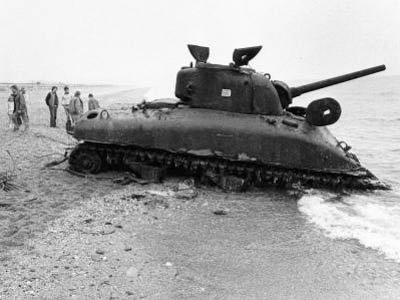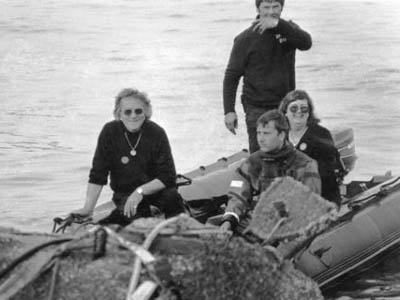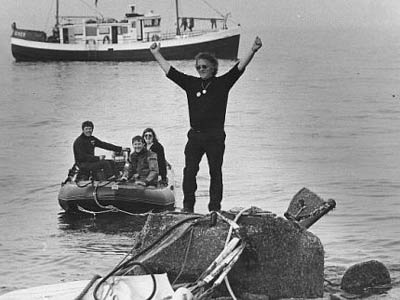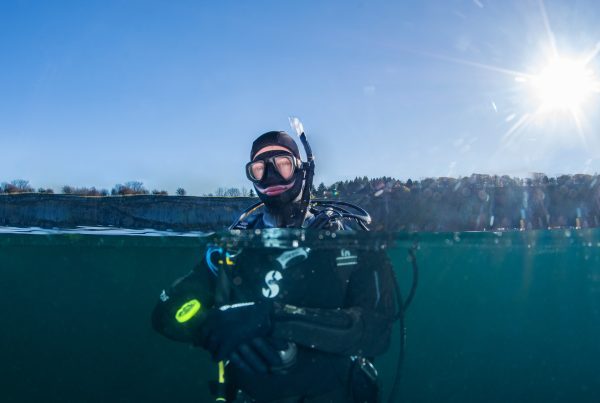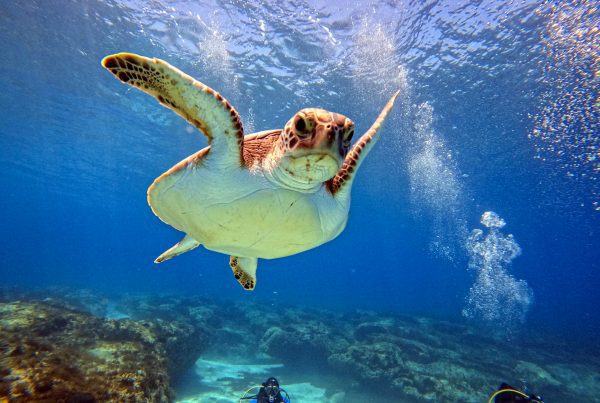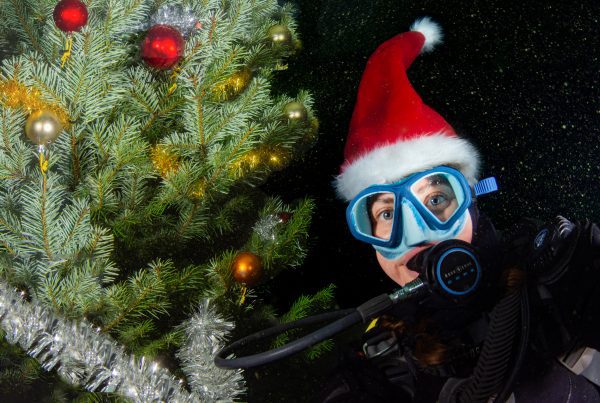Written by Chris Mills
Club member Chris Mills tells us all about how he became involved in scuba diving and his dreams of working on the lucrative, but dangerous oil rigs. He recalls a remarkable story of his part in raising an American tank, following a top-secret mission during WWII, which went south and resulted in 800 servicemen being killed.
My introduction into the world of scuba diving was not via the more usual route of joining a club, or taking a course on holiday, but through the commercial diving world.
In 1984, at the ripe old age of 21, I had a good friend who was a North Sea commercial diver, working on the oil rigs in Scotland. This was at a time when the Scottish oil industry was relatively new and the work was very dangerous. Divers were creaming it in! My friend would get home from a few weeks on the rigs with a bulging brief case stashed with cash and then have months off in the winter for travelling. At 21, what was not to like? He’d bought himself a brand new TR7 (I know…) after just a few months work no less!!
So off I packed down to Plymouth, booked on my 6 week course that would get me my first stage inshore diving work certificate. I had never dived before although had always been a strong and confident swimmer.
It was a tough course. We were up at the crack of dawn with a long run in our wetsuits before the first of three dives most days, with classroom theory time in between. During the first two weeks we were taught to scuba dive, initially in the harbour and then out to sea in the dive boat. Our group of 11 soon shaped up into a lean, mean fighting team and we became a close and ‘well oiled’ unit. Three of the guys were from the BBC special effects team that made underwater sets for films. When they started using dynamite to blow things up under water for action shots their boss thought it was high time they got some kind of proper training! The stories they told us about some of their antics were hysterical.
Having got through the scuba module which gained us a PADI open water advanced certificate, we moved on to the serious kit. Full face hard helmets with intercoms and surface supplied air via umbilical lines. Wearing one of these helmets for the first time was seriously weird. You couldn’t pinch your nose to equalise your ears but had to put your nose over a rubber, snot covered pad inside the helmet and hope you could make a seal.
Coupled with the fact you wore lead boots rather than fins, and a serious amount of lead strapped around you, it was scary sh** jumping off the harbour wall at the mercy of your buddy tender to break your fall with the umbilical line and lower you down, hopefully the right way up! We tried a variety of different helmets and, like our 10 year old leaky dry suits, you could say some of the gear was more than a little ropey!
We then moved on to the pneumatic tool work module. This was fun. We had to go to the sea bed and practice drilling holes into a large rock for an hour or so that was already filled with previous holes. I soon realised if I stuck the drill bit into an old hole and tied the drill handle control up with a bit of seaweed I could lie on the bottom and get a much needed kip – the instructor above totally satisfied with all the pneumatic air coming up that drilling must be going well. We also got to use hot water suits with a hose pipe plugged into our wetsuits that flushed through many capillary tubes. It was quite easy to get burnt!
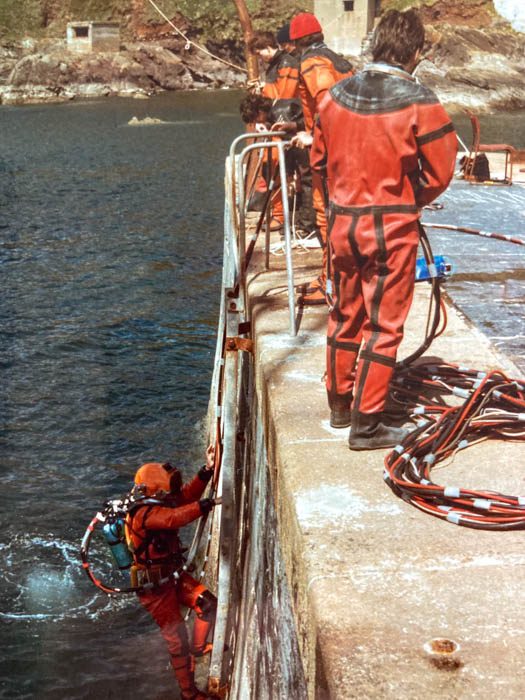
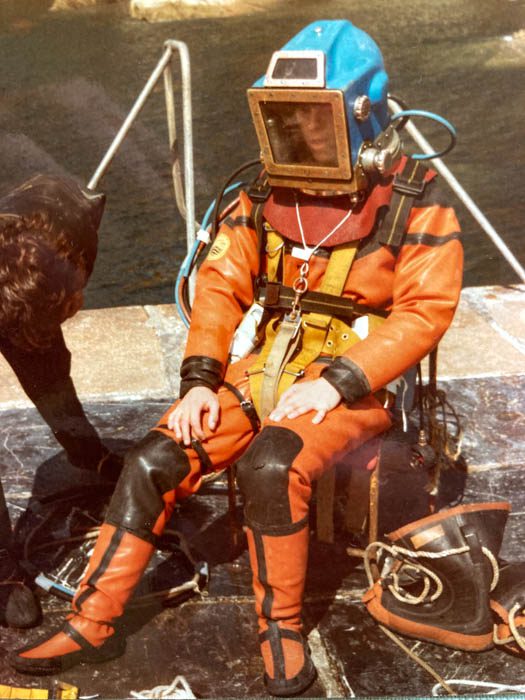
We would go quite far out of Plymouth Sound on the big dive boat and did many interesting dives, often in near darkness and very strong currents, streaming out like a flag holding on to the shot line for dear life down at 50 metres. Some seriously dangerous decompression stops on the way up. We learnt about surveying and under water pipe work.
As I was nearing the end of my course, the dive school was approached by a man called Ken Small who was a local Devon resident from around Slapton Sands. He needed some commercial divers for a big operation.
A few months prior to the WW2 D-Day landings on 6th June 1944, thousands of allied troops, mostly Americans, took over many villages around Slapton and Torcross to practice their beach assault landings with their landing craft and Sherman tanks. It was a top-secret exercise known as Exercise Tiger. Thousands of locals were forcibly evacuated from their homes and not told why.
During one evening of exercises in Start Bay, several fast German E-boats stormed in and torpedoed several of the massive landing craft containing numerous tanks and hundreds of men. One of the two Royal Navy guard warships had been damaged at the time and was in harbour for repair, leaving the fleet exposed like sitting ducks.
As a result of this, and several other disasters during the exercise, around 800 American servicemen were killed. Orders were put out that no one was to talk about the disaster to protect the D-Day invasion secrecy. Even decades afterwards families of the dead had no details other than “died in service”. There had been no formal burials – just a cover up of the disastrous exercise.
For 10 years Ken Small campaigned tirelessly to get some kind of recognition for these men. From speaking to fishermen, he knew the location of one of the sunken Sherman tanks, about a mile out to sea in Start Bay, that had been there since the 1944 Exercise. Being an American tank, he had to battle through red tape to get the rights to it.
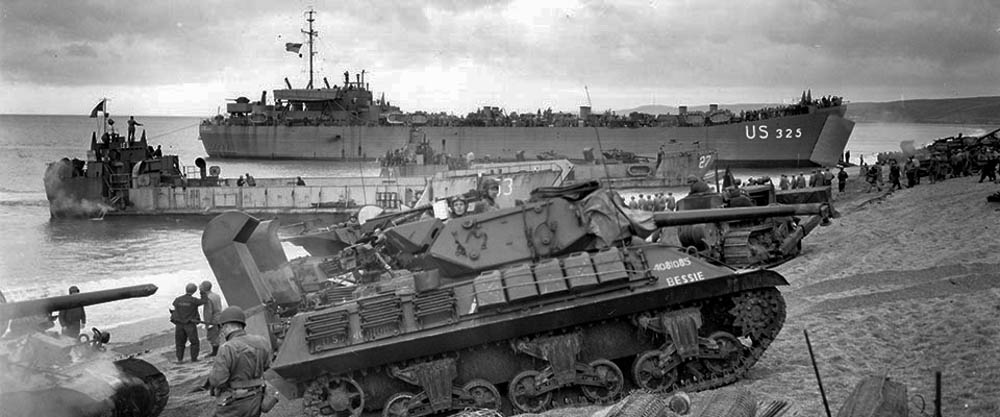
Image courtesy https://exercisetigermemorial.co.uk/
Finally, whilst I was on my 1984 diving course, Ken got the green light from Washington to raise the tank. My group were tasked with preparing the 34 ton tank for lifting with air bags from 60 feet depth and bring it to the surface. It would then be towed to the beach at high tide behind the dive boat. Teamed up with my BBC buddy, we were the first two divers to go down and had to cut many fishing nets away from the front runners. We didn’t know it at the time but there were massive conger eels all over it.
The next stage was to attach 10 ton air bags to each corner of the tank and after much jostling, up she came. It was incredible. Once on the beach it was dragged up by bulldozer and remarkably the runners were going round and it was in great condition.
Ken restored the tank and it is now beautifully sighted, on a plinth with an information plaque, just off the beach at Torcross. He received much praise from President Regan for what he did. Finally, after forty years, the families of the dead were updated properly and there was a tangible monument to remember their great sacrifice, giving families much needed closure. Many, many American families now come over each year and there is an ever-increasing annual military remembrance service at the tank.
Since writing his excellent book, “The Forgotten Dead” Ken has since passed away and his son Dean proudly follows in his father’s great work. I met Dean a short while ago at the tank and he was very excited when I gave him a copy of my dive logbook for that first dive on the tank in 1984. He signed a copy of his father’s book for me, thanking me for my part.
Needless to say, being involved with the raising of the tank was a very proud and moving experience for me in what it represented.
Funnily enough, straight after my course, I was offered a job as a sailing instructor in the Greek Isles and then Turkey for a few seasons. I jumped at the chance. Just prior to setting off for the Mediterranean, I was contacted by Paramount Pictures. They were filming Lady Jane at Hever Castle, starring Patrick Stewart and Helena Bonham Carter. They urgently needed a diver on standby before they could film shots by the moat in case any of the actors fell in wearing their chain armour! I rushed over. Hardly oil rig work, and, having moved on to other things it turned out to be my only paid work as a commercial diver but I have enjoyed much overseas scuba diving on and off over the years.


